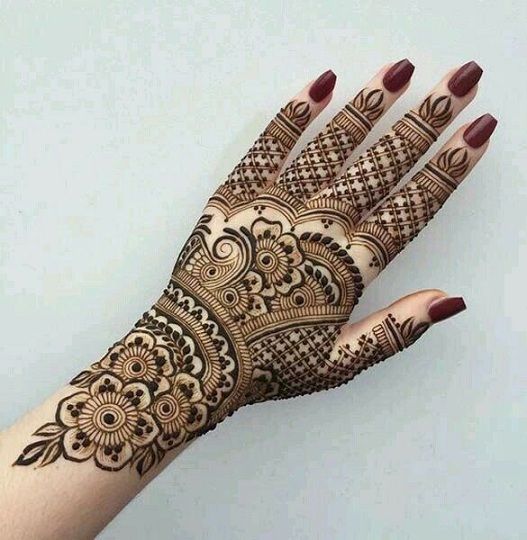Simple Mehndi Design
Introduction
Mehndi, has been an integral part of cultural traditions for centuries. Its intricate patterns and earthy aroma have the power to captivate anyone who encounters it. Among the myriad of mehndi designs that exist, the simplicity of a well-executed simple mehndi design is both timeless and elegant. In this article, we will delve into the world of simple mehndi designs, exploring their beauty, significance, and the techniques behind their creation.
Types Of Simple Mehndi Designs
1. Traditional Indian Mehndi Design

Traditional Indian mehndi designs are known for their intricate patterns, rich symbolism, and cultural significance. These designs often feature peacocks, lotus flowers, paisleys, and intricate geometric shapes. They are commonly applied on the hands and feet of brides during weddings and represent love, prosperity, and good fortune.
2. Arabic Mehndi Design

Arabic mehndi designs are characterized by their bold, floral patterns that cover the hands and feet. They usually leave more open space, creating an elegant and airy look. Arabic designs often emphasize the beauty of negative space and are popular for both casual and special occasions.
3. Moroccan Mehndi Design

Moroccan mehndi designs are inspired by the geometric patterns found in Moroccan architecture and art. These designs feature intricate lattice work, zigzags, and diamond shapes. Moroccan henna art often extends further up the arms and legs, creating a striking and symmetrical appearance.
4. African Mehndi Design

African mehndi designs draw inspiration from the rich cultural diversity of the continent. These designs incorporate elements like tribal symbols, animals, and traditional African patterns. African henna art is not only visually appealing but also holds deep cultural significance.
5. Western Fusion Mehndi Design

In recent years, Western fusion mehndi designs have gained popularity among individuals looking for a modern twist on traditional henna art. These designs often incorporate elements like hearts, stars, and abstract shapes, catering to a more contemporary aesthetic.
6. Minimalist Mehndi Design

Minimalist mehndi designs are characterized by their simplicity and clean lines. These designs use basic shapes and patterns to create subtle, understated beauty. They are ideal for those who prefer a more subdued henna look or have limited time for application.
7. Glitter and Colored Mehndi Design

To add a touch of glamour and vibrancy to traditional henna art, glitter and colored mehndi designs have emerged. These designs incorporate glitter, rhinestones, and colored henna to create a dazzling and eye-catching effect, perfect for parties and celebrations.
Understanding Simple Mehndi Designs
Simple mehndi designs are characterized by their minimalistic approach to henna application. These designs often focus on clean lines, open spaces, and uncomplicated patterns. They are a popular choice for various occasions, from casual gatherings to formal events, owing to their versatility and understated charm.
Significance of Simple Mehndi Designs
1. Elegance and Simplicity:

Simple mehndi designs are known for their elegance and simplicity. They enhance the natural beauty of hands and feet without overwhelming them. This makes them suitable for people of all ages and backgrounds.
2. Quick Application:

Unlike intricate bridal mehndi designs that may take hours to complete, simple mehndi designs can be applied relatively quickly. This is particularly beneficial for those who have busy schedules but still want to adorn their hands with henna.
3. Versatility:

Simple mehndi designs can be tailored to suit various occasions. Whether it’s a family gathering, a festival, or a wedding, you can choose a design that complements the event’s atmosphere and your personal style.
Creating Simple Mehndi Design
Creating simple mehndi designs requires a steady hand, practice, and the right materials. Here’s a basic guide to get you started:
1. Gather Your Materials: You’ll need fresh henna paste, a cone or applicator, and essential oils like eucalyptus or lavender to enhance the henna’s color and longevity.
2. Prepare Your Skin: Ensure your skin is clean and free from oils or lotions. Exfoliating beforehand can help the mehndi adhere better.
3. Design Selection: Choose a simple design that suits your preferences. Common elements include flowers, leaves, paisley patterns, and geometric shapes.
4. Practice: Before applying the design on your skin, practice on paper or a smooth surface. This will help you get accustomed to the flow of the henna and improve your accuracy.
5. Application: Start with the central element of your design and work your way outwards. Maintain a steady hand and even pressure on the cone to create uniform lines and shapes.
6. Drying Time: Allow the mehndi to dry naturally. Avoid smudging or touching it until it has completely dried, which can take anywhere from 30 minutes to a few hours.
7. Sealing: Apply a sugar-lemon mixture or a specialized mehndi sealant to help the design last longer and intensify its color.
Conclusion
Simple mehndi design have a unique charm that transcends time and trends. Their elegance, versatility, and ease of application make them a popular choice for individuals looking to adorn their hands and feet with henna art. Whether you’re a seasoned mehndi artist or a beginner, exploring the world of simple mehndi designs can be a rewarding and creative experience, allowing you to express your style and celebrate cultural traditions in a beautiful way.



